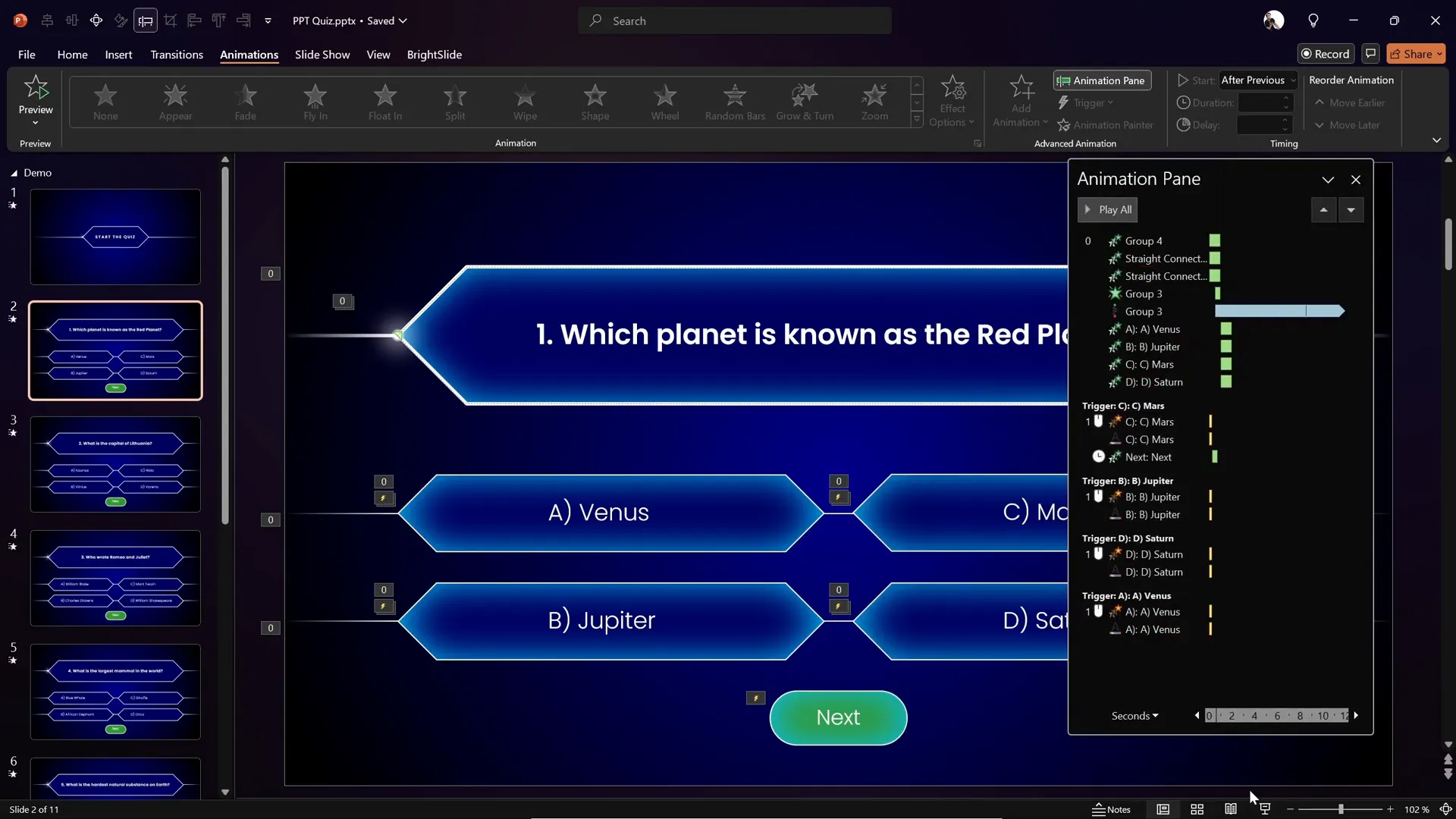
PowerPoint is not just for static presentations anymore. With a few clever tricks, you can create dynamic, interactive content that engages your audience and makes learning fun. One exciting way to do this is by building an interactive quiz right inside PowerPoint. Whether you’re an educator, trainer, or just want to add some flair to your presentations, an interactive quiz can boost engagement and retention.
In this detailed tutorial, based on the expert guidance from Juan Skill of One Skill PPT, you’ll learn how to create a beautiful, functional quiz with clickable answers, instant feedback, and smooth navigation—all powered by hyperlinks and animation triggers. Plus, you’ll get tips on design, animation, and slideshow setup to make your quiz professional and user-friendly.
Table of Contents
- Introduction to the Interactive Quiz Demo
- Designing the Quiz Background and Visual Elements
- Creating and Styling the Diamond Answer Buttons
- Setting Up the Start Button with Hyperlink
- Configuring PowerPoint Kiosk Mode for Controlled Navigation
- Animating Correct and Wrong Answers with Triggers
- Adding the Next Button to Proceed After Correct Answers
- Duplicating and Customizing Question Slides
- Additional Entrance Animations and Pro Tips
- FAQ About Creating Interactive Quizzes in PowerPoint
- Conclusion
Introduction to the Interactive Quiz Demo
Before diving into the tutorial, let’s explore the interactive quiz you will be able to create by the end of this guide. The quiz features questions with multiple-choice answers presented as diamond-shaped buttons. When a user clicks an answer, instant feedback is provided:
- Wrong answers turn red, indicating the choice is incorrect.
- The correct answer turns green, and a “Next” button appears to proceed.
This creates a smooth, engaging user experience that keeps participants interested and motivated to continue.
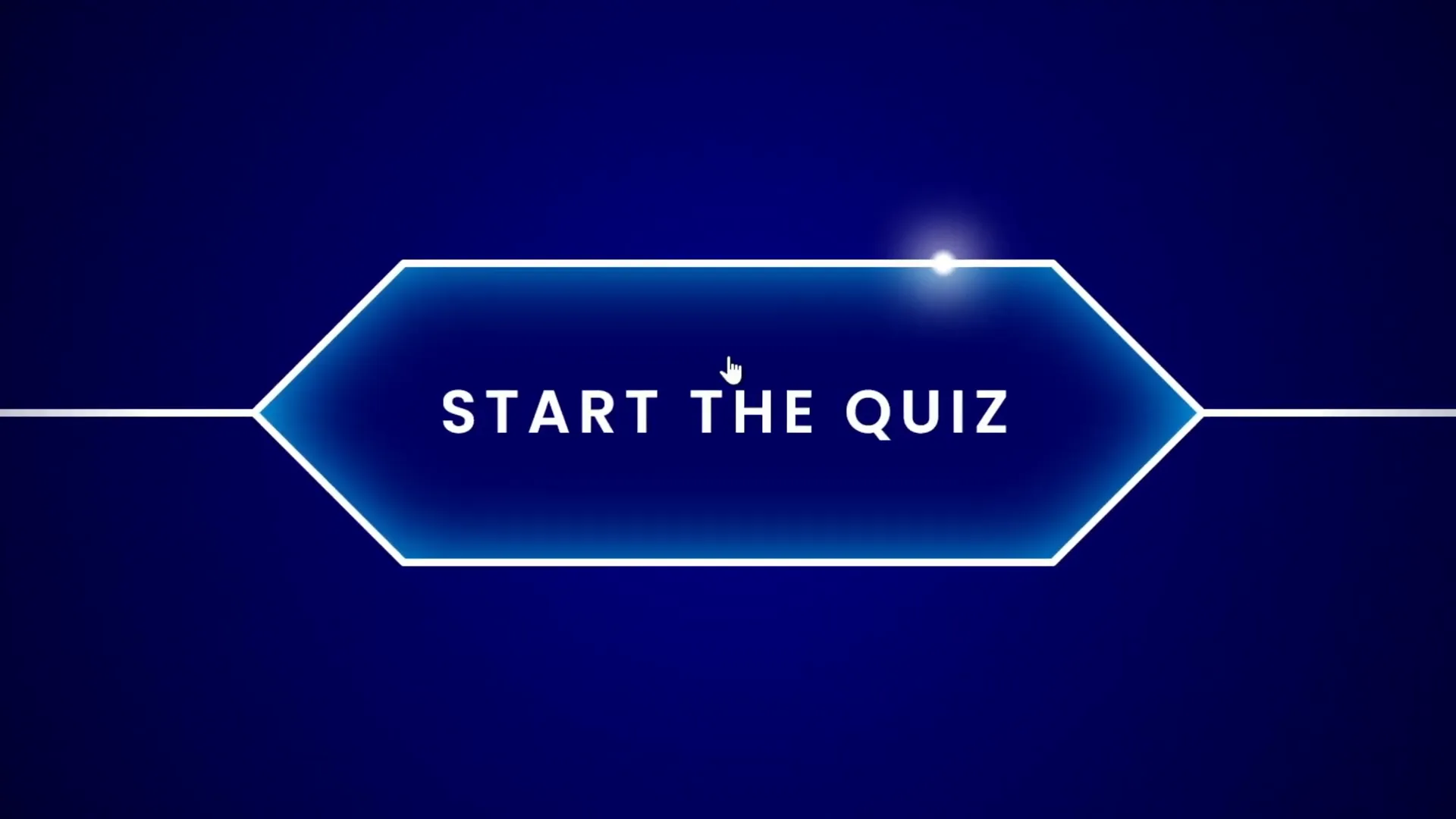
The example quiz used in this tutorial includes five questions:
- Which planet is known as the red planet? (Correct answer: Mars)
- What is the capital of Lithuania? (Correct answer: Vilnius)
- Who wrote Romeo and Juliet? (Correct answer: William Shakespeare)
- What is the largest mammal in the world? (Correct answer: Blue whale)
- What is the hardest natural substance on earth? (Correct answer: Diamond)
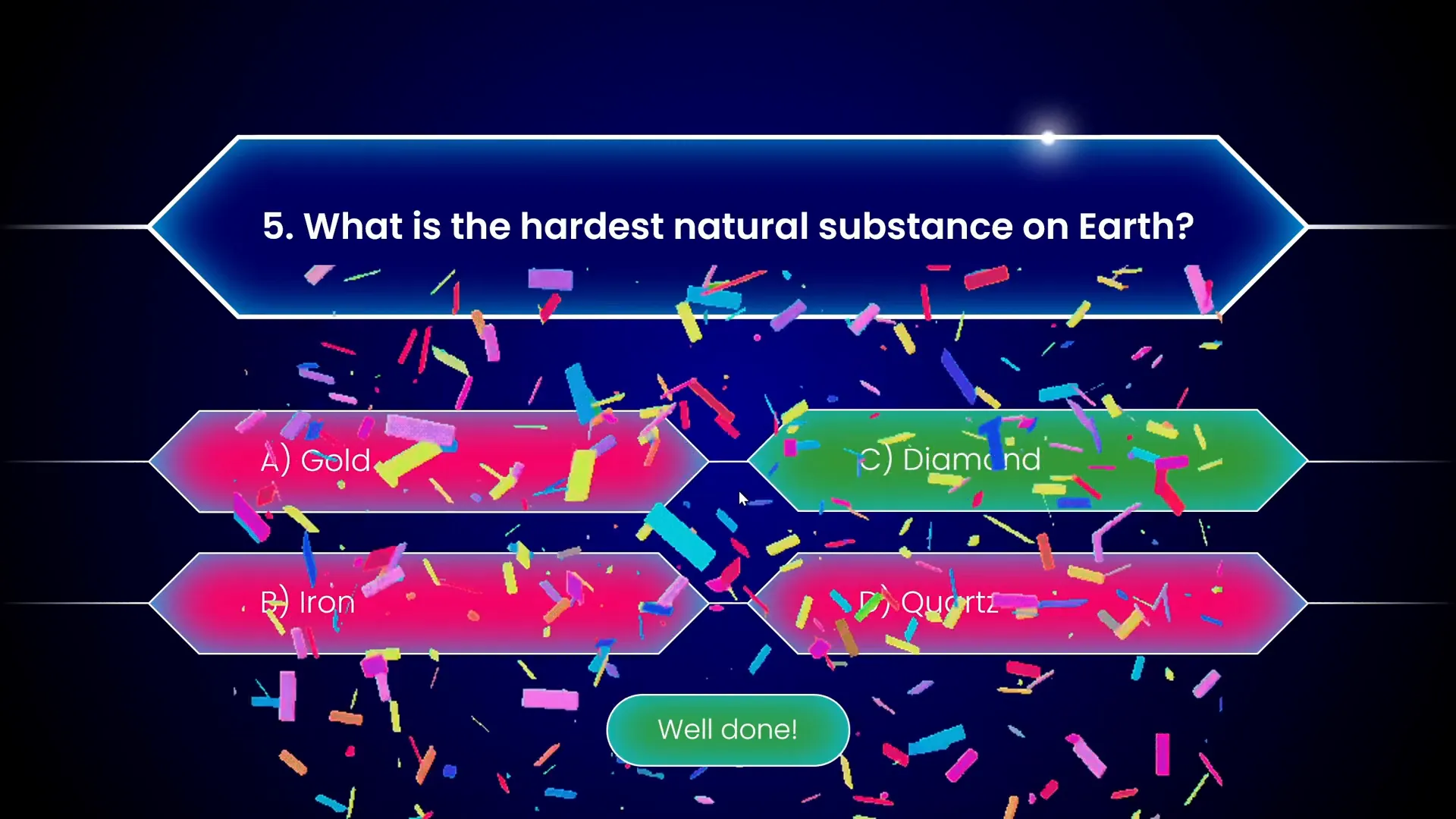
Once you understand the quiz flow, you can create as many question slides as you want, making this a scalable solution for any quiz or trivia game.
Designing the Quiz Background and Visual Elements
Starting with a clean slate, Juan demonstrates how to transform a plain white slide into an attractive quiz background using gradient fills in PowerPoint:
- Open the Format Background pane and select Gradient fill.
- Use two color stops for the gradient:
- First stop: Dark blue (custom hex code provided)
- Second stop: Black at 95% position for a smooth fade effect
- Adjust the gradient direction and position to your liking to achieve a subtle yet elegant background.
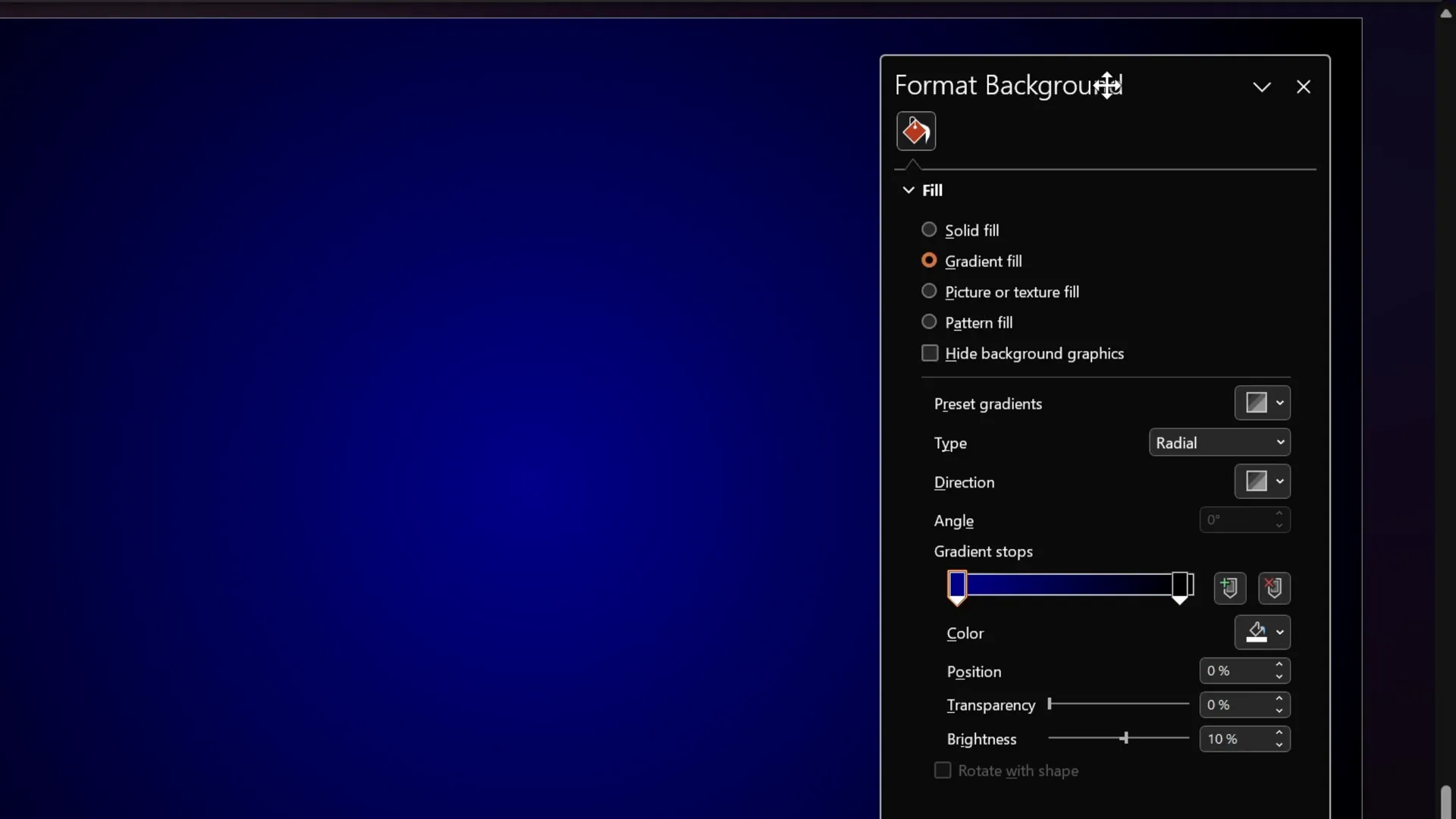
This gradient background sets a professional and visually appealing tone for the quiz, creating contrast for the interactive elements.
Creating and Styling the Diamond Answer Buttons
The diamond-shaped answer buttons are a key visual element that makes the quiz stand out. Here’s how to create and style them quickly:
- Go to Insert > Shapes and select Rectangle: Diagonal corners snipped.
- Adjust the yellow handles on the shape to create a perfect diamond shape.
- Copy the formatting of an existing styled diamond shape using Ctrl + Shift + C.
- Apply the style to the new shape with Ctrl + Shift + V.
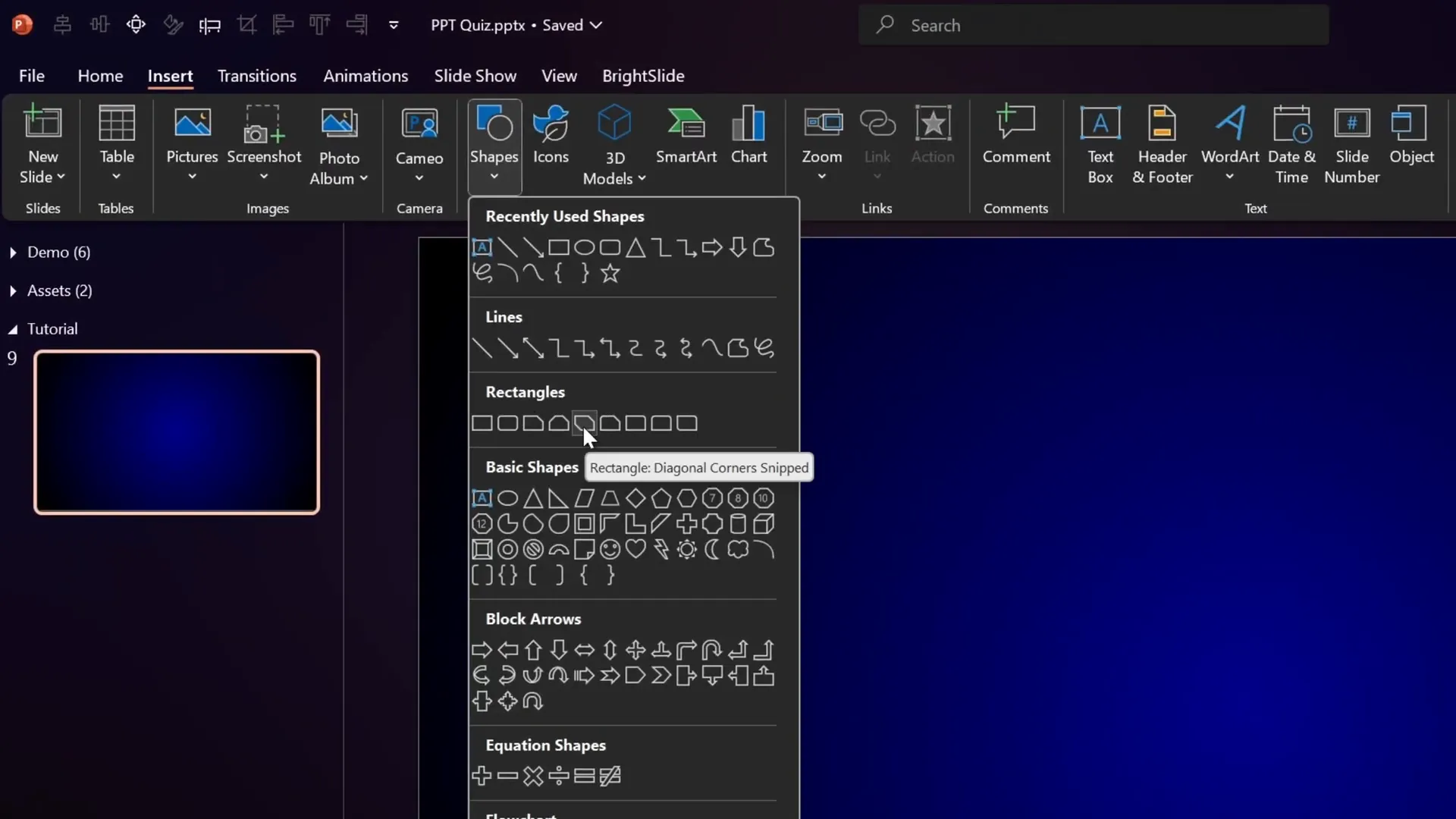
The styling details include:
- A solid fill matching the background’s blue color
- A white outline with a thickness of 3 points
- A subtle inside shadow with a bright color for depth (preset: inside center shadow, blur 40 points)
- Text formatted with the Poppins Semi Bold font for clarity and style
Double-click inside the diamond to add text, such as “Start the Quiz” on the first button.
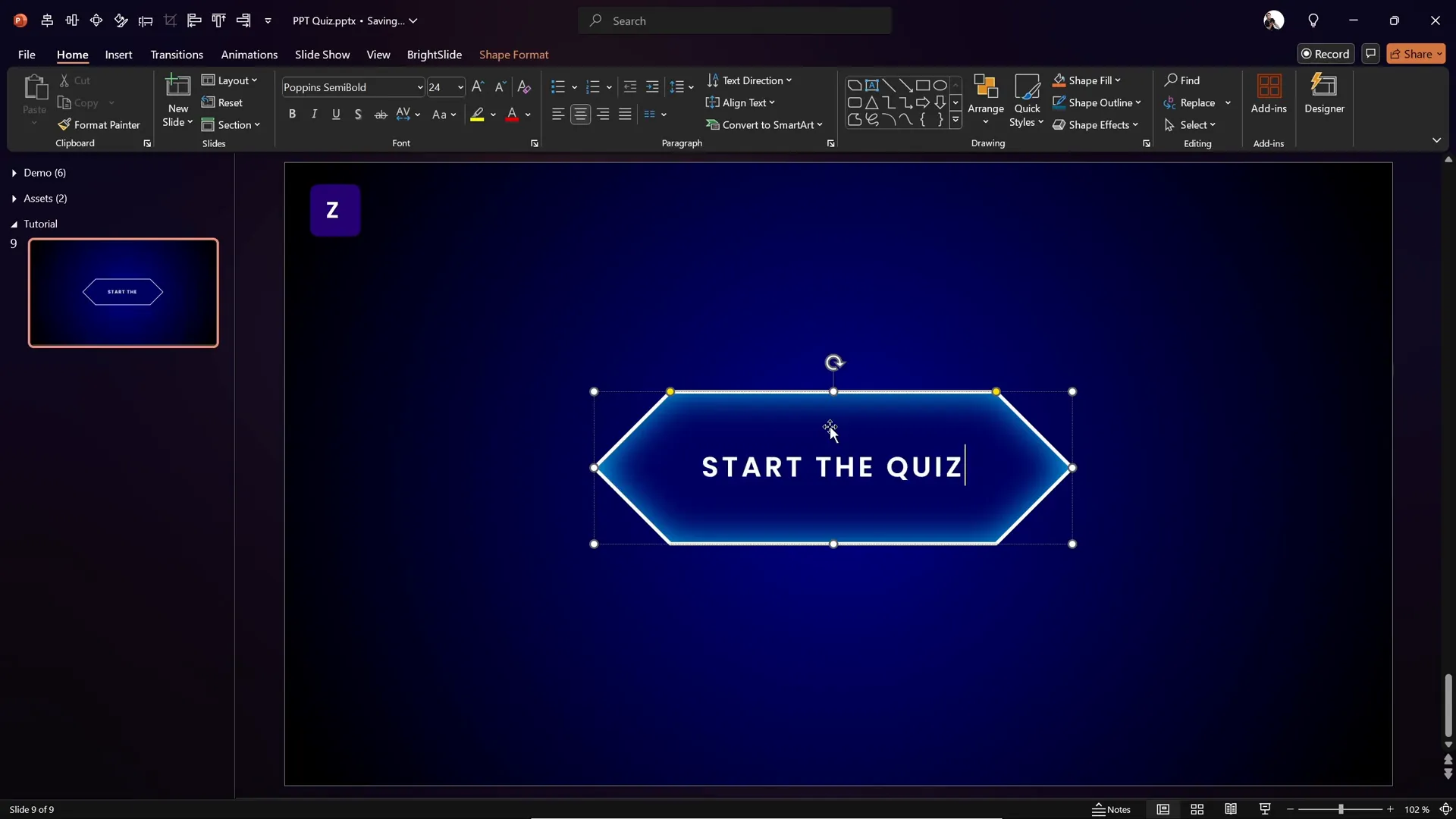
Setting Up the Start Button with Hyperlink
To make the quiz interactive, the “Start the Quiz” button needs to navigate the user to the first question slide:
- Select the diamond shape with the start text.
- Go to Insert > Link.
- Choose to link to the Next Slide.
- Click OK.
This hyperlink lets users begin the quiz by clicking the start button.
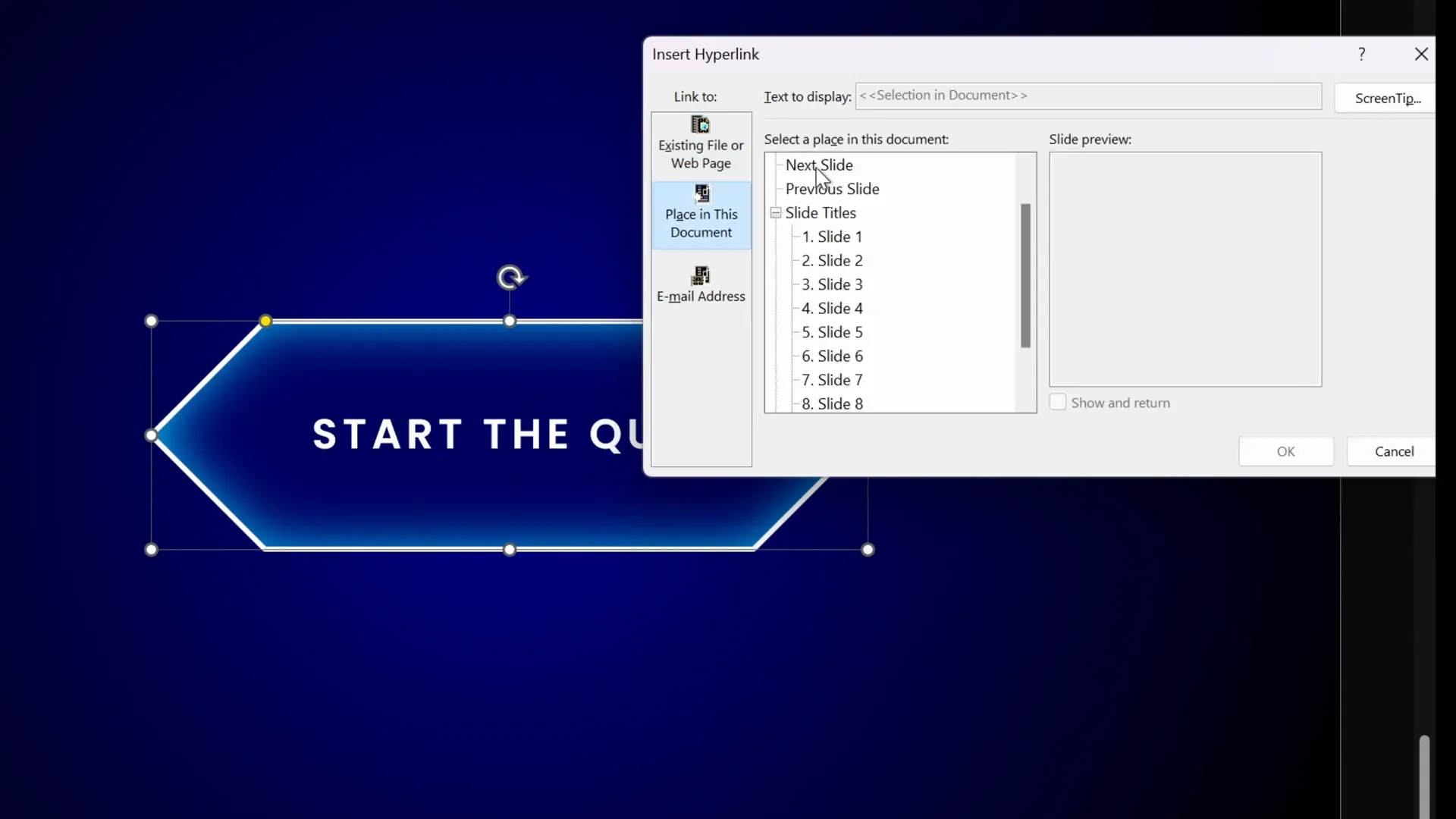
Configuring PowerPoint Kiosk Mode for Controlled Navigation
One of the most important setup steps is configuring the slideshow to run in Kiosk Mode. This mode disables the usual slide navigation via mouse clicks or keyboard arrows, ensuring participants can only move through the quiz by clicking the interactive buttons you set up.
Here’s how to enable kiosk mode:
- Go to the Slide Show tab.
- Click on Set Up Slide Show.
- Under Show type, select Browsed at a kiosk (full screen).
- Click OK.
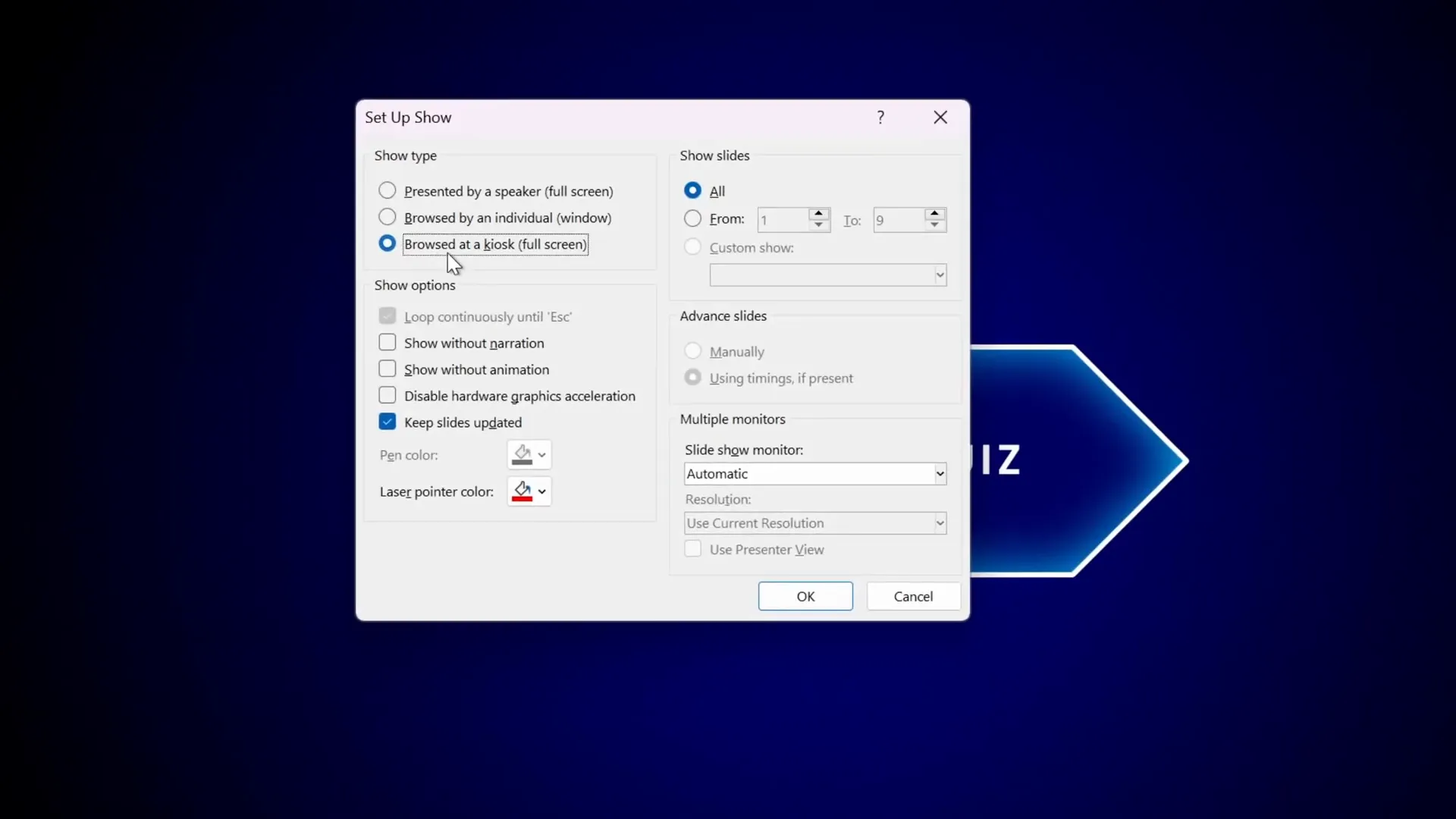
This setting prevents accidental slide jumps and forces users to use your interactive buttons, making the quiz experience seamless and controlled.
Note: If you leave the presentation in the default “Presented by speaker” mode, clicking anywhere on the slide will advance to the next slide, which is not desired for an interactive quiz.
Animating Correct and Wrong Answers with Triggers
Now comes the magic of interactivity: animating the answer buttons to respond visually when clicked.
Juan uses two types of animations for the answer buttons:
- Object Fill Color Change to turn the button red (wrong) or green (correct).
- Font Color Change to keep the text visible (typically white) after the fill color changes.
Here’s how to set up the animation for a wrong answer button:
- Select the shape representing the wrong answer.
- Open the Animations tab and then the Animation Pane.
- Add an Emphasis animation called Fill Color or Object Color.
- Set the animation to start On Click.
- Adjust the duration to 0.25 seconds for a quick effect.
- In the animation options, pick a red or purple shade for the fill color.
- Open the Trigger menu and set the animation to start On Click of that exact shape (e.g., shape named “a”).
- Add a second animation for Font Color, set to start With Previous and same duration, changing the font color to white.
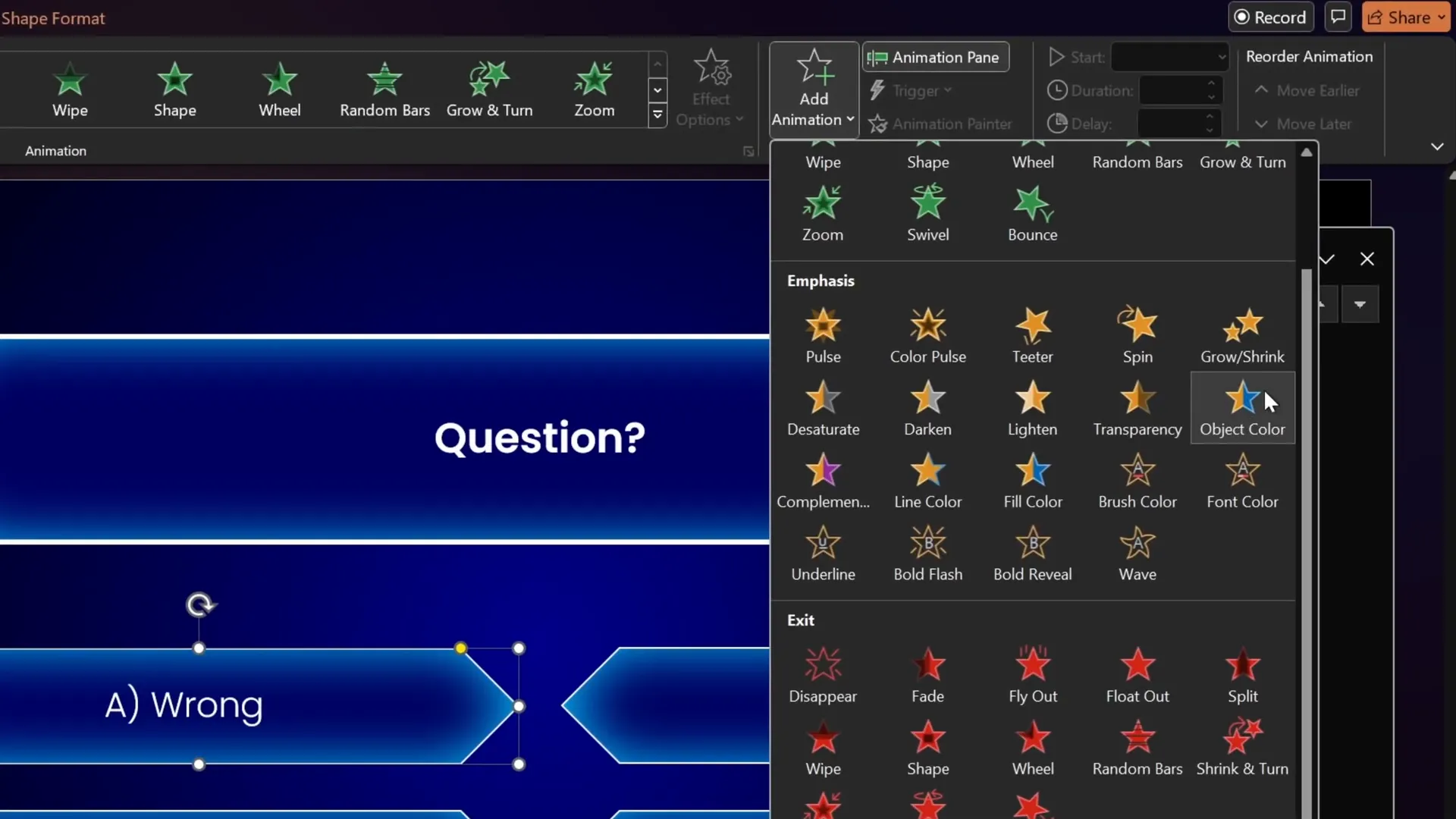
This two-animation combo ensures that when a user clicks a wrong answer, the diamond button turns red but the text remains visible in white.
To apply the same animations to other answer buttons quickly, use the Animation Painter tool:
- Select the animated shape.
- Double-click the Animation Painter icon.
- Click on other shapes to copy animations.
- Press ESC or click the painter icon again to stop.
For the correct answer button, repeat the process but choose a green fill color instead.
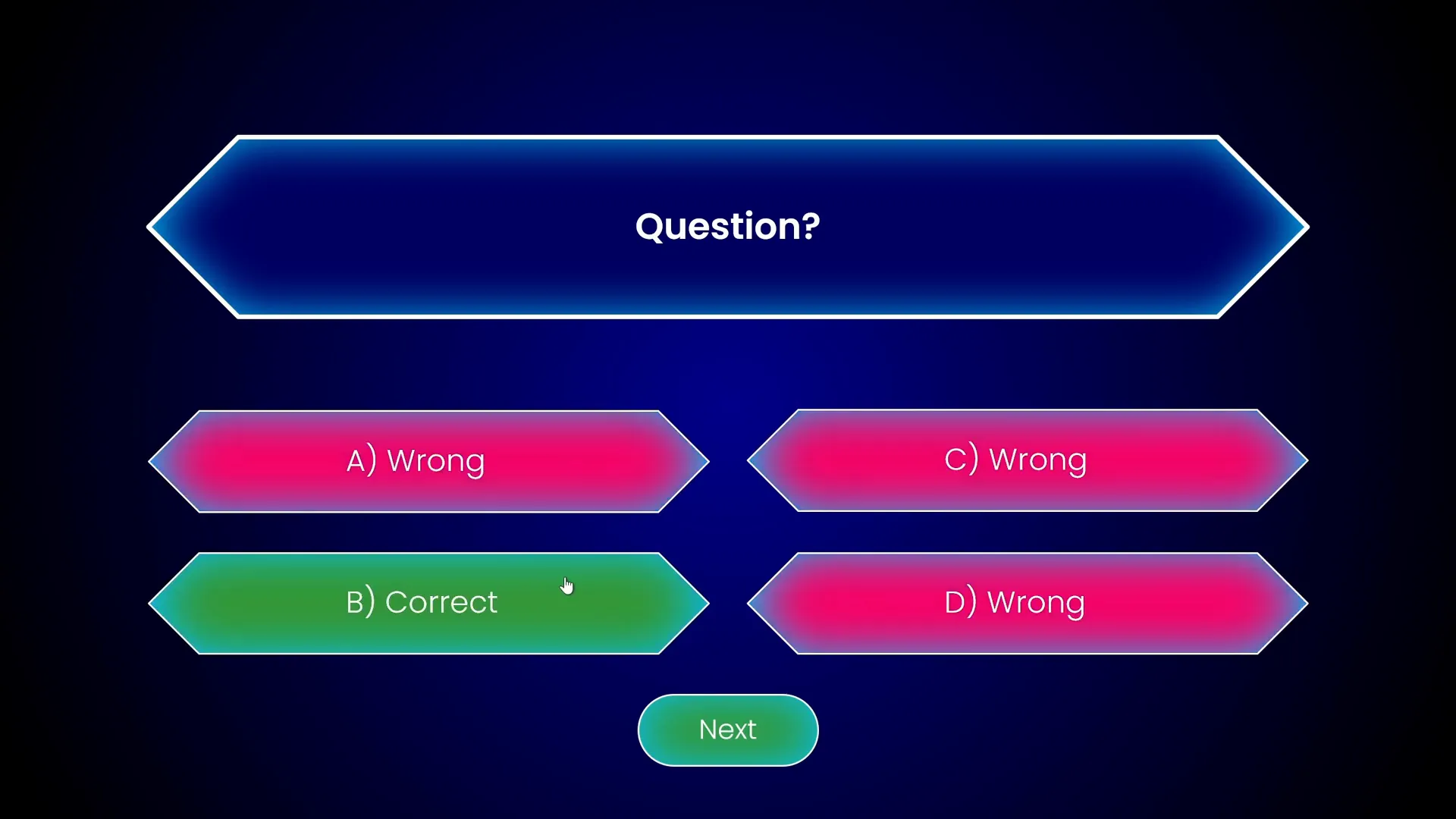
Adding the Next Button to Proceed After Correct Answers
Once the correct answer is selected, a “Next” button should appear, allowing the user to proceed to the next question. Here’s how to add this:
- Create the “Next” button shape and position it at the bottom of the slide.
- Set its initial visibility to hidden (e.g., by placing it off-slide or setting no entrance animation initially).
- Add an entrance animation such as Fly In from the bottom.
- Set the animation to start After Previous.
- Group this animation with the correct answer’s animations by assigning the same Trigger (i.e., on click of the correct answer shape).
- Ensure the “Next” button has a hyperlink to the next slide.
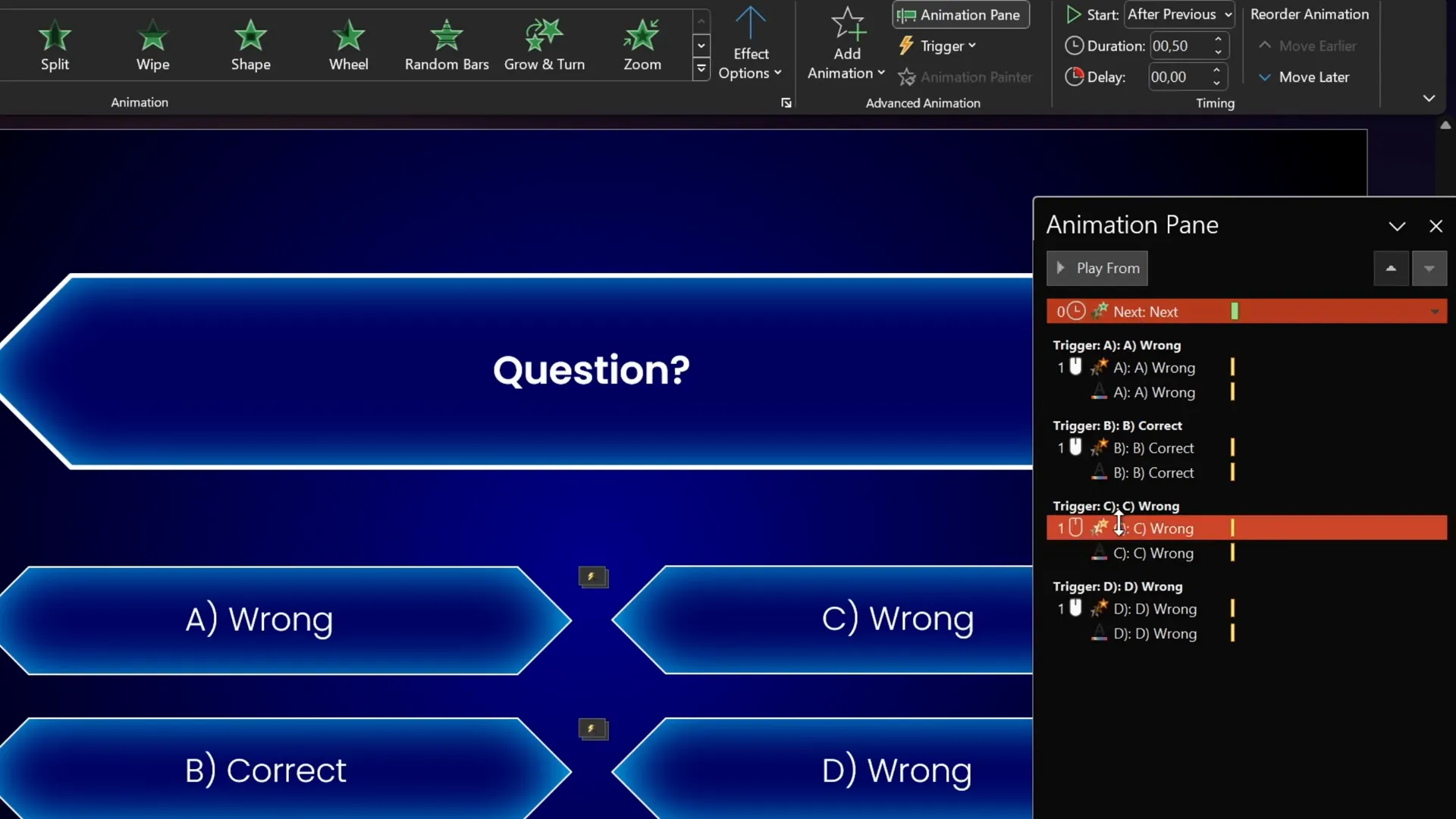
When the user clicks the correct answer, the button turns green, the text stays white, and the next button smoothly flies in from the bottom, inviting the participant to continue.
Duplicating and Customizing Question Slides
After setting up one question slide with animations, you can quickly duplicate it to create the entire quiz:
- Select the slide in the left pane.
- Right-click and choose Duplicate Slide.
- Change the question text and answers accordingly.
- Modify which answer is correct and which are wrong by adjusting the animations’ colors and triggers in the animation pane.
- Ensure the “Next” button is linked correctly and grouped with the right trigger.
This process saves significant time and ensures consistency across all questions.
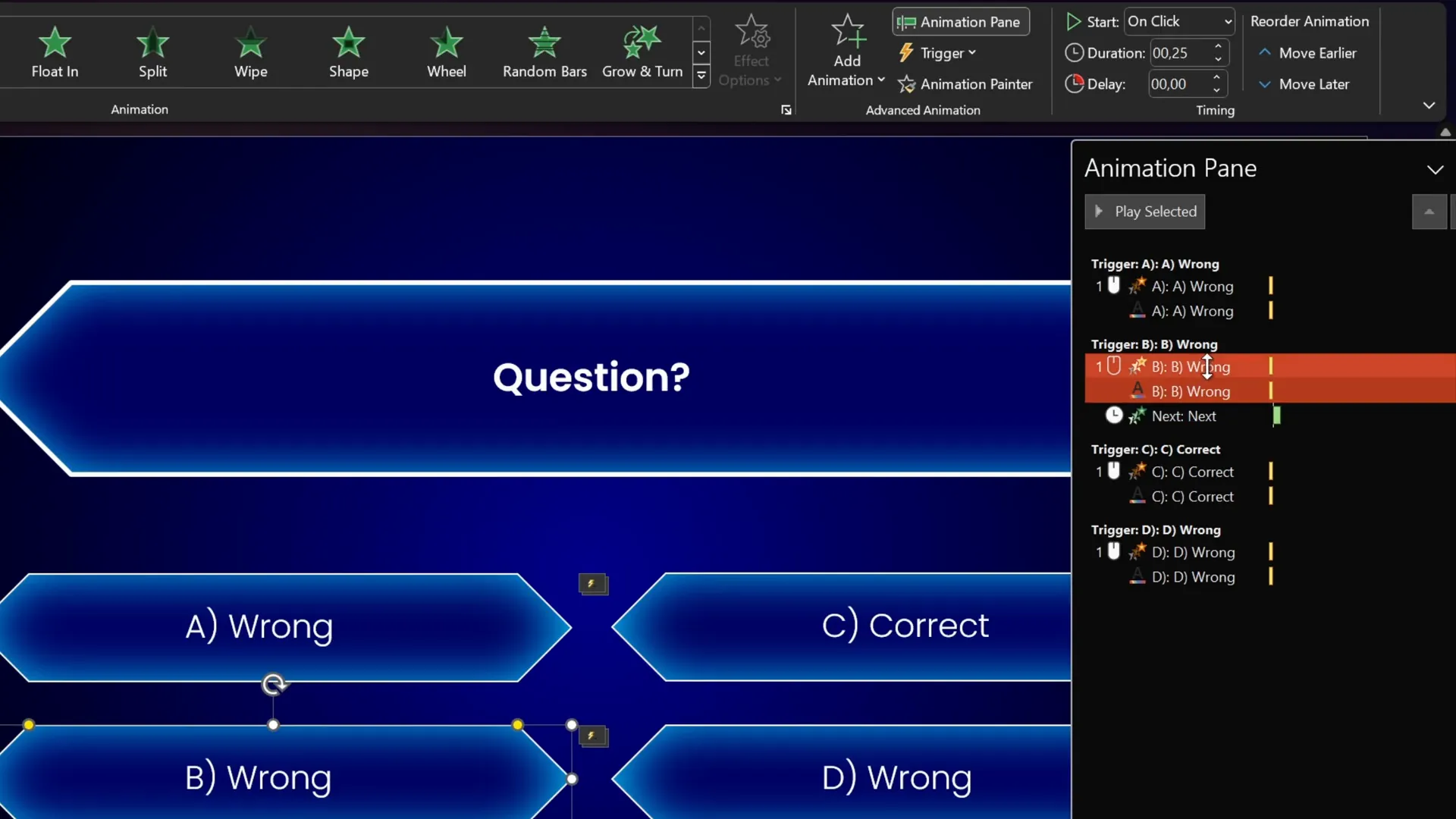
Additional Entrance Animations and Pro Tips
Juan mentions that you can add extra entrance animations for the question elements (title, answers, buttons) to make the quiz feel more polished and dynamic. These animations can be simple fades or fly-ins that happen when the slide loads.
For example:
- Fade in the question text
- Fly in each answer button with a slight delay
- Animate the “Next” button only upon the correct answer click
These subtle details enhance the user experience and make the quiz more engaging.
Juan also invites viewers to comment if they want tutorials on creating specific animations, such as confetti or highlight effects, showing the flexibility and creativity PowerPoint allows.
FAQ About Creating Interactive Quizzes in PowerPoint
1. What version of PowerPoint do I need to create this interactive quiz?
You need a version of PowerPoint that supports animation triggers and advanced hyperlinking, typically PowerPoint 2016 or later for Windows. Mac versions may have limited support for triggers.
2. Can I create quizzes with more than four answer options?
Yes, you can add as many answer buttons as you like by duplicating the diamond shapes and adjusting animations and triggers accordingly.
3. How do I share or distribute my interactive quiz?
You can save your PowerPoint file and share it directly. For best results, ensure recipients use PowerPoint in slideshow mode with kiosk mode enabled. Alternatively, convert your presentation to a video or interactive PDF, but note that animations and triggers may not work in those formats.
4. Can I customize the design and colors of the quiz?
Absolutely! You can change colors, fonts, and shapes to match your brand or theme. The tutorial uses a blue and black gradient with diamond shapes, but feel free to experiment.
5. How do I reset the quiz for multiple users?
PowerPoint doesn’t automatically reset animations during a slideshow. You’ll need to restart the presentation to reset the quiz for the next user.
6. Is there a way to score the quiz automatically?
PowerPoint alone does not support automatic scoring. However, you can simulate scoring with creative animations or use third-party tools or add-ins for more advanced quiz functionality.
Conclusion
Creating an interactive quiz in PowerPoint is a fantastic way to engage your audience, whether for education, training, or fun trivia. With a combination of thoughtful slide design, clever use of shapes, hyperlinks, animation triggers, and kiosk mode setup, you can build an intuitive and visually appealing quiz experience.
This tutorial from Juan Skill of One Skill PPT breaks down the process step-by-step, from designing the background and buttons to animating user feedback and navigation. The best part is that you can customize every aspect to suit your content and style.
Remember to:
- Set your slideshow to kiosk mode to control navigation
- Use triggers so animations respond only to clicks on specific answers
- Duplicate slides to save time when adding questions
- Add entrance animations for polish and engagement
By mastering these techniques, you’ll not only create quizzes but also learn powerful PowerPoint skills that can elevate any presentation.
To get started right away, download the free PowerPoint quiz template linked in the original video description by One Skill PPT, and customize it for your own needs.
Happy quizzing!
